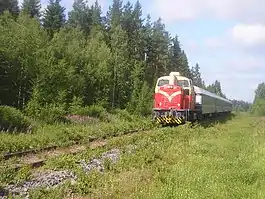Haapamäki–Seinäjoki railway
The Haapamäki–Seinäjoki railway is a railway running between the Haapamäki railway station and the Seinäjoki railway station in Finland. It is part of the historical Tampere–Vaasa railway; its other segments as known today include Tampere–Haapamäki and Seinäjoki–Vaasa.[1]
| Haapamäki–Seinäjoki railway | |
|---|---|
 A Dv12-pulled regional train between Alavus and Tuuri | |
| Overview | |
| Status | Open |
| Owner | Finnish government |
| Locale | Central Finland South Ostrobothnia |
| Termini | |
| Continues from | Tampere–Haapamäki railway |
| Service | |
| Operator(s) | VR Group |
| History | |
| Opened | 22 November 1882 |
| Technical | |
| Line length | 117.9 km (73.3 mi) |
| Number of tracks | 1 |
| Track gauge | 1,524 mm (5 ft) |
| Electrification | None |
| Operating speed | 100 km/h (62 mph) |
Overview
The Haapamäki–Seinäjoki railway stretches approximately 117.9 kilometres (73.3 mi) long, connecting the regions of Central Finland and South Ostrobothnia. It consists of one track for its entire length, and is unelectrified.[2]
History
The construction of the Tampere–Vaasa railway became relevant towards the end of the 1870s. In 1877-1878, the line was confirmed, and the formal decision to build the line was made during the concurrent session of the Diet of Finland. The construction was initiated in 1879; the section between Vaasa and Alavus was opened for provisional traffic on 10 November 1882, and the Tampere–Alavus segment followed on November 22. In September 1883, the railway was formally inaugurated and transferred under the ownership of the Railway Administration.[3]
Services
VR Group operates two daily regional train services in each direction on the route Jyväskylä–Seinäjoki, as well as two additional services per direction between Seinäjoki and Ähtäri. On the Haapamäki–Seinäjoki line, these services call in Pihlajavesi, Myllymäki, Eläinpuisto-Zoo, Ähtäri, Tuuri and Alavus.[4]
References
- Iltanen, Jussi (2010). Radan varrella: Suomen rautatieliikennepaikat (in Finnish). Karttakeskus. ISBN 978-951-593-214-3.
- Voutilainen, Jarkko; Peni-Nyman, Anniina; Kiiskinen, Lauri (2020). Vähäliikenteiset radat: Tilanne ja tulevaisuus 2020 (PDF). Helsinki: Finnish Transport Infrastructure Agency. pp. 68–72. ISBN 978-952-317-789-5.
- Valanto, Sirkka (1982). Suomen rautatieasemat vuosina 1857-1920 (in Finnish). Helsinki: Finnish Heritage Agency. p. 44. ISBN 951-9074-68-6.
- "VR long-distance traffic timetable for the period 28 March−6 June 2021" (PDF). VR Group (in Finnish). Archived (PDF) from the original on 14 March 2021. Retrieved 3 April 2021.
External links
 Media related to Haapamäki–Seinäjoki railway at Wikimedia Commons
Media related to Haapamäki–Seinäjoki railway at Wikimedia Commons